Soledad-Segundo semestre
|
caught my eye surfing.....
|
Dining & Wine |
| Knife Skills: Creating Feasts for the Eyes By KATE MURPHY Published: May 14, 2008 |
 Michael Temchine for The New York Times LIKE SURGERY, BUT A LOT MORE FUN In James Parker's hands, a watermelon becomes a blossom. |
LOOKING at a butternut squash and a fistful of rhubarb, James Parker sees a jellyfish and its tentacles. Show him a carton of pineapples and he will envision stacking them end to end to form the trunk of a palm tree. Pumpkins put him in mind of the sun and red peppers suggest its rays. Mr. Parker is one of the leading talents in the art of fruit and vegetable carving. Once a dusty formality that lived on in the form of radish roses in out-of-the-way hotels, food art, as it is known, is enjoying a new vogue. The services of its top practitioners are much in demand, providing them with a nice income between fiercely fought carving competitions. "We're seeing more fruit and vegetable entries every year that are incredibly creative," said Thomas Smyth, chairman of the Salon of Culinary Art, an annual competition sponsored by the Société Culinaire Philanthropique in New York. Recent eye-catchers, he said, have included melons carved to look like Fabergé eggs and lifelike cockatiels made of butternut squash, carrots and papaya. Faced with this efflorescence of edible statuary, the culinary association, which was founded in 1865, was moved to create a special prize for produce art in 2005. Similarly, elaborately carved fruit and vegetable centerpieces have won out over ice, pastry, sugar, chocolate and cheese sculptures in some recent international, national and regional competitions sponsored by the American Culinary Federation, the nation's largest chef's organization. Mr. Parker, who works in Washington, D.C., has competed twice in the Food Network Challenge, featuring fruit and vegetable carving. The most recent contest is to be shown on Sunday. "When something is picked up by the Food Network, you're definitely looking at a trend," Mr. Parker said. He worked as a garde-manger a cook who prepares cold foods for six years at various hotel restaurants before quitting in 2001 to focus on fruit and vegetable art. He frequently does battle with other carvers but, he said, "When I get beat in competitions, it eats me alive." Mr. Parker was particularly incensed last year when, in the first Food Network Challenge, his five-foot-high floral arrangement made of carved produce lost to an exuberant jungle scene with daikon radish monkeys and rutabaga tiki gods carved by Doug St. Souver, a carpenter turned culinary student. "Parker didn't like some newbie getting all the glory," said Mr. St. Souver, who now runs his own carving business, Artisans in Culinary, in Davisburg, Mich. "What do you expect? We're passionate and creative people so it's only natural for us to be competitive." Professional produce artists like Mr. Parker and Mr. St. Souver create centerpieces costing thousands of dollars for restaurants, resorts, caterers and individual clients. They are in demand at trade shows to give demonstrations (some of which can verge on performance art) and to teach lessons at fees of up to $750 per hour. Many sell instructional DVD's and carving sets. "Business was slow when I first started but now I'm constantly busy," said Mr. Parker. Novice and professional chefs as well as people who hate to cook come from as far away as Israel and Korea to take his classes, he said. Some produce artists, like Hugh McMahon, whose work will be displayed in a photography exhibition at the James Beard Foundation next month, specialize in pumpkins and watermelons, into which they carve intricate bas-reliefs of corporate logos and portraits of people like Frida Kahlo and Mark Twain. (Mr. McMahon typically places lights inside, lending his work a radiance Ms. Kahlo might have envied.) Sometimes a piece of fruit with a peculiar shape will catch an artist's eye and suggest an entire sculpture. Carvers will spend hours searching for a quirky eggplant or an exceptional quince. "It's fun to walk through the produce market and look for things to carve," said Pam Maneeratana, who carves fruits and vegetables for a restaurant she owns with her husband in Gainesville, Fla. "I look at the colors and shapes and imagine what something might become when I cut it up." Some kinds of produce play the same roles again and again. Berries and grapes usually stand in for the buds or centers of flowers. Cantaloupe and honeydew melons turn up as dahlias. |
Carrots and peppers of all sorts accent floral scenes or provide the beaks and claws of birds. Dried beans and papaya seeds make animal eyes. The fibers from spaghetti squash might represent a maiden's blond hair, and baby corn might become a flower stamen inside a calla lily made of shaved jicama. Playing With Food Jicama, along with daikon and rutabaga, are favored for carving three-dimensional figures because they are firm and don't brown. Jimmy Zhang, a chef in San Francisco, is regarded as a master of this kind of sculpture, transforming taro root into mice or a sweet potato into a stallion. Ray Duey, a former restaurant chef in Torrance, Calif., who quit to become a professional produce carver four years ago, is known for his commissioned pieces, like a depiction of the Last Supper carved from five watermelons. He also teaches carving to chefs and caterers nationwide, including cooks in the United States Navy and Coast Guard. "It's crazy that you can make a living playing with your food," he said. In fact, some culinary trend watchers said the current appetite for whimsical produce art may have started with Saxton Freymann's work in the 1997 book, "Play With Your Food." His brussels sprout pigs and bok choy fish have been featured on greeting cards, calendars and in several subsequent books. But many observers in the food service industry say what's really driving the fruit and vegetable art fad is increased competition for customers. Robert Gilbert, chef de cuisine for Disney's Contemporary Resort Catering and Conventions, said that to wow visitors, over the past two years he and his staff have constructed ever more elaborate fruit and vegetable displays for example, filling glass aquariums with produce carved to look like shells and underwater sea creatures, accented with tufts of wheat grass and mushrooms fashioned to look like logs. |
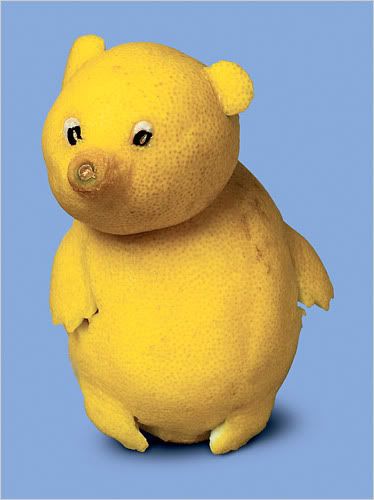 Saxton Freymann SO YOU THOUGHT YOU COULD CHOP Saxton Freymann's lemony bear. |
| Some resorts, cruise ships, restaurants and caterers hire full-time produce carvers, many of them from Asia, where carving has been considered an art form for centuries and is sometimes taught to schoolchildren. Ms. Maneeratana, who is from Thailand and moved to the United States in 1979, was among them. "I remember an exam in middle school where I had to carve three pounds of sweet potatoes before I got just the right jasmine flower," she said. Today, in her spare time, she teaches. While rat and roach exterminators attended seminars at the National Pest Management Association Convention in Orlando last October, she showed their spouses how to make teapots from cantaloupes, which, she said, was "a lot of fun." Many chefs, bored by the precisely defined tasks that often characterize their work at restaurants or catering operations, carve fruits and vegetables as a creative release. "It's the way I'm able to express myself when I'm not on the job," said Michael Verno, the garde-manger at the Mandarin Oriental in Miami. "I've been doing it on the side for about 20 years, and right now I'd have to say I'm doing my best work." Carving sets of 30 or 40 pieces are available, but most carvers seem to rely on only half a dozen tools. Like many of his colleagues, Mr. Verno chiefly uses a very narrow, thin and flexible knife with a curved tip, sometimes called a Thai knife. The knives render fine details, like eyelashes or the veins on a leaf. "I get a guy in California to grind mine," he said. "It's not the kind of thing you can pick up at Williams-Sonoma." No matter what kind of blade does the work, the sculptures have one thing in common. They begin to decay as soon as they are finished, if not before. "I spray my carvings with vegetable oil," Mr. St. Souver said. "It gives it a sheen and keeps in the moisture." Other sculptors said frequently misting their work with water keeps it looking fresh. But eventually, the pirate galleons and tableaus of King Tut are reduced to refuse or compost. This fate does not seem to bother the carvers, though. "It's what makes our art all the more precious," Mr. Duey said. |
|
 |
| May 12th, 2008 (6:25am) RIM Throws Down with BlackBerry 9000 Announcement Judi Sohn |
| The rumor mill has been churning for months, with both RIM and Apple gearing up for Round 2 in the smartphone wars. Apple fans hope the next iPhone stomps the BlackBerry into the ground for business users, while the CrackBerry addicts hope the next BlackBerry will make their favorite device just as much fun as the competition. While we speculate on why Apple discontinued online sales of the iPhone, RIM wasted no time in making a formal announcement of the BlackBerry 9000 (aka BlackBerry Bold) this morning. There are few surprises in this announcement, since fan site CrackBerry.com has been playing with and talking about the new device for the past few weeks. |
 |
| Blackberry 9000 |
In short, the new BlackBerry has a much sharper screen, more RAM (1 GB), wifi, 3G, GPS and a camera. Even better, most reports say the keyboard is easier to work with than the one on the 8800 series. The new BlackBerry OS features better email (HTML!), better browser, better media handling and DocumentsToGo for editing Office files. It even syncs with iTunes (on a PC-only, I assume). RIM says it will be released "this summer" so that can mean anywhere from June to September. Most sites are predicting an August release date. So if you believe the rumor sites, RIM has the first press release but Apple may actually be the first to ship. Which is the "killer" and which is the "target" depends on who you talk to, and whether your phone/mobile email use is dictated by your employer. What do you think of the new BlackBerry? Is it enticing or are you still holding out for that 3G iPhone? |
| Copyright 20012008 Giga Omni Media, Inc. All rights reserved. Design & Marketing consulting by ACS. Powered by WordPress.com. |
 Travel. |
| Good start at the first gay residence for senior citizens in Pattaya By Armin Grebe, Pattaya Published: Issue of May, 2008.
|
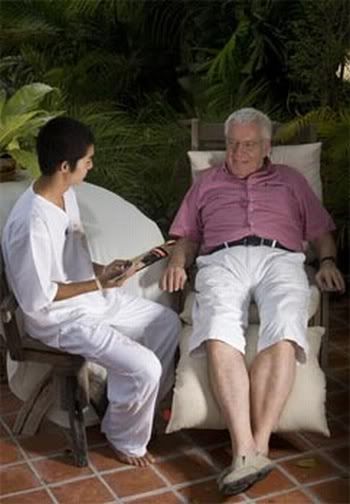 |
| After we moved into our residence beginning of February we made many smaller and bigger changes and redecorated things. During our trip to Chiang Mai we bought many decorative items and additional furniture, so now every studio has its own character and distinct color. Khun Rewat, our new staff member, who speaks English and German well, took active part in our many endeavors. Presently he lives here too, in order to water the garden before sunset and preparing breakfast for our guests. Because of his side job as gardener, Rewat has bought a special hat to protect him from the sun. The color of his hat is pink, of course. He now walks proudly through our garden and watches his successes in gardening. |
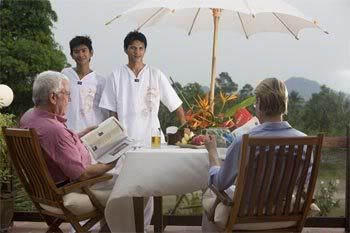 |
In the mean time the first visitors have arrived for a trial period. First came an elderly gay man from Germany who is married for thirty years. He came with his wife who cannot travel alone anymore after undergoing several head surgeries. Both enjoyed their time here and relaxed completely. They were happy to have found a possibility to spend time in Thailand in a friendly and careing environment, where they had nothing to worry about. They preferred that to an anonymous stay at an impersonal hotel. They liked very much to take a nude swim early morning and they mostly did the same again after sunset. We even could convince them to take up excursions around Pattaya. Rewat even took them out to Boyztown, a venture the lady would not have dared taking up alone being feeble and she was not at all jealous when the husband naturally had some additional fun that night. |
 |
| They took much advantage of our driving services and appreciated the German speaking companion since both of them spoke hardly any English. As next visitor we had an elderly gay man who lives in Thailand for a long time already. He is in ill health after several operations and a stroke and can hardly live alone any longer. He has an unreliable houseboy who constantly is after his money but delivers little care. Rewat looked after him very well. The guest suffered of sleeplessness caused by anxiety, he does not feel secure in his house alone any longer. The third night here he slept right through after we had convinced him not to drink a liter of milk before going to bed which is certainly not good for health and not good for his weight, too. |
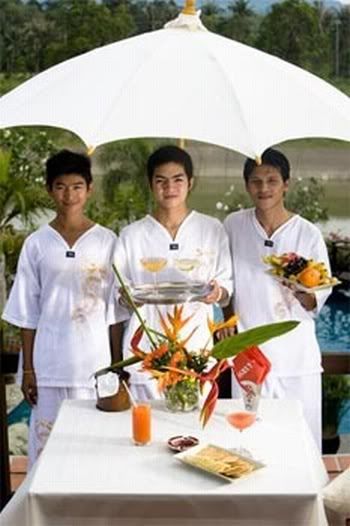 |
| He enjoyed his first cup of tea in the pool before breakfast and loved watching two humming birds taking over an abandoned nest and changing it for their needs. And he also fed the night guard, Nicknoy, the baby cat. Staying with us he got to know a seventy year old lesbian who had fled Pattaya during the water battles of Songkran. They befriended each other, spent a lot of time together and will stay in touch even after their departure. To the dinners Rewat never appeared without having put on fresh powder on his face. Whole life stories were exchanged after dinner, we played games or just enjoyed a glass of wine, the casual and amicable meetings often lasted till midnight. Rewat ended the day mostly by taking up another swim. We tried hard to change his strange swimming method, but he felt his way (like a dog) was far superior to ours (like frogs). After that remark of his all the farangs tried his method, but went under. |
 |
| In the mornings our guests took up a lot of activities. One took his swim in the pool, there were discussions where breakfast should be served, either on the terrace, the Club House or on our lake beach. Our female guest watered the garden before sunrise together with Rewat and cut lovingly some flowers in the garden; as a former florist she knew exactly what she was doing and decorated all of our rooms with flowers. Rewat feared, she would undo all his planting endeavors in the garden. At night Nicknoy could be convinced to sleep in her bed, so she proudly announced next morning that she did not have had to sleep alone again. While our guests stayed with us we often had interested visitors who wanted to get to know us and our project. We surely had an entertaining and interesting starting up phase. And, when our first guest finally left, we felt a bit sad, too. |
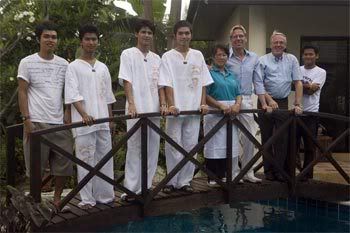 |
| After a long preparation period our project for a gay residence for the elderly has taken off well. To celebrate this we will give discounts of 35 % for people interested in trial periods with us. Hopefully, we can welcome you with us soon. Warm welcome, Armin Grebe und Juergen Diederichs, Gaydreamresidence Morning Cloud, Huay Yai, Thailand Those who would like to know more about the gay residence for the elderly can visit their Website through Pink Pages of Sticky Rice Gay Guide Asia und Gay Guide World. Go to Thailand, then Pattaya and there you are. |
 |
Open article at Sticky Rice´s Web Site. |
|